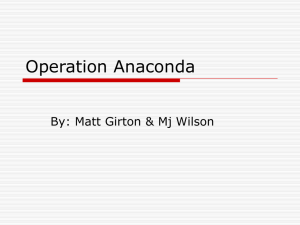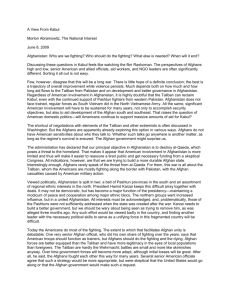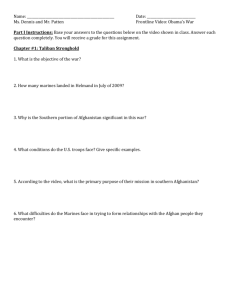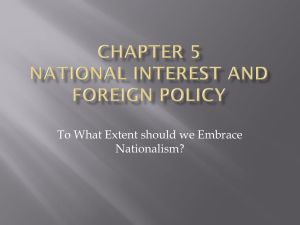Testimony by Mark L. Schneider, Sr. Vice President, International Crisis... the Senate Foreign Relations Committee on “Afghanistan – Continuing Challenges”
advertisement
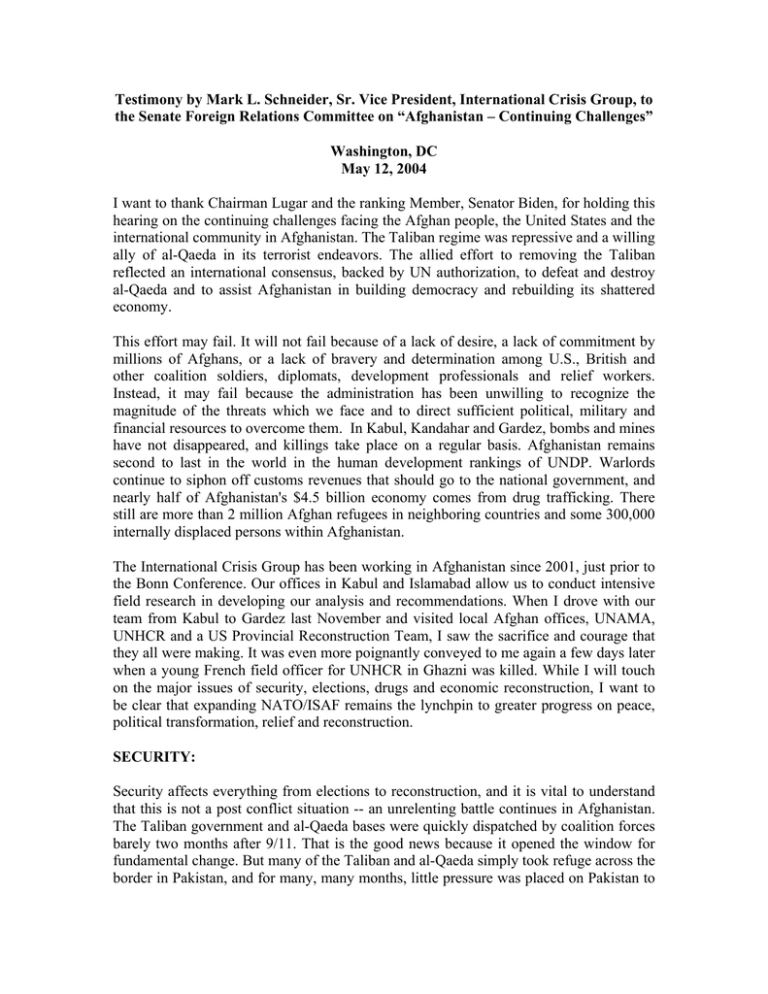
Testimony by Mark L. Schneider, Sr. Vice President, International Crisis Group, to the Senate Foreign Relations Committee on “Afghanistan – Continuing Challenges” Washington, DC May 12, 2004 I want to thank Chairman Lugar and the ranking Member, Senator Biden, for holding this hearing on the continuing challenges facing the Afghan people, the United States and the international community in Afghanistan. The Taliban regime was repressive and a willing ally of al-Qaeda in its terrorist endeavors. The allied effort to removing the Taliban reflected an international consensus, backed by UN authorization, to defeat and destroy al-Qaeda and to assist Afghanistan in building democracy and rebuilding its shattered economy. This effort may fail. It will not fail because of a lack of desire, a lack of commitment by millions of Afghans, or a lack of bravery and determination among U.S., British and other coalition soldiers, diplomats, development professionals and relief workers. Instead, it may fail because the administration has been unwilling to recognize the magnitude of the threats which we face and to direct sufficient political, military and financial resources to overcome them. In Kabul, Kandahar and Gardez, bombs and mines have not disappeared, and killings take place on a regular basis. Afghanistan remains second to last in the world in the human development rankings of UNDP. Warlords continue to siphon off customs revenues that should go to the national government, and nearly half of Afghanistan's $4.5 billion economy comes from drug trafficking. There still are more than 2 million Afghan refugees in neighboring countries and some 300,000 internally displaced persons within Afghanistan. The International Crisis Group has been working in Afghanistan since 2001, just prior to the Bonn Conference. Our offices in Kabul and Islamabad allow us to conduct intensive field research in developing our analysis and recommendations. When I drove with our team from Kabul to Gardez last November and visited local Afghan offices, UNAMA, UNHCR and a US Provincial Reconstruction Team, I saw the sacrifice and courage that they all were making. It was even more poignantly conveyed to me again a few days later when a young French field officer for UNHCR in Ghazni was killed. While I will touch on the major issues of security, elections, drugs and economic reconstruction, I want to be clear that expanding NATO/ISAF remains the lynchpin to greater progress on peace, political transformation, relief and reconstruction. SECURITY: Security affects everything from elections to reconstruction, and it is vital to understand that this is not a post conflict situation -- an unrelenting battle continues in Afghanistan. The Taliban government and al-Qaeda bases were quickly dispatched by coalition forces barely two months after 9/11. That is the good news because it opened the window for fundamental change. But many of the Taliban and al-Qaeda simply took refuge across the border in Pakistan, and for many, many months, little pressure was placed on Pakistan to deny them sanctuary. Taliban political and military leadership moved with relative ease. The just announced Pakistani proposal to provide amnesty to foreign forces in South Waziristan, bordering on Afghanistan, presumably including al-Qaeda, in return for pledges of "good behavior," is particularly disturbing. The Taliban and other Islamic extremists are still recruiting and have built up their strength. If anything, the capacity of Taliban and al-Qaeda today to maintain a deadly insurgency across the south and southwest of the country appears to be increasing. Within Afghanistan, there has also been an unwillingness to take on the hard work of disarming and demobilizing regional warlords and militias, despite its crucial linkage to political stability and to controlling the drug trade. Al-Qaeda and Taliban attacks on UN, NGOs and Afghan government officials have nearly doubled over the past four months compared to last year. More NGO staff were killed in these first four months than all of 2003. Two schools recently rebuilt with international aid were burned down in a village south of Kandahar and a senior Muslim cleric critical of the Taliban was assassinated in Kandahar city. And it is not limited to the south and southeast. Only last week, two British private security contractors and an Afghan elections worker were killed in the north eastern province of Nuristan. A year ago, Secretary Rumsfeld spoke of having US troops leaving Afghanistan by June of this year. There needs to be a clearer understanding that achieving real security on the ground is the only way to pave the way for a successful exit strategy. We were pleased to note that last month there was an increase of some 2,000 US Marines, bringing US forces up to 15,500. These troops need to be there—and maybe even more troops need to be there until Afghan security forces are capable of defending the country against whatever remains of an armed al-Qaeda and Taliban military forces. Getting the security services up and running has moved in fits and starts. The US has bolstered the German-led coordinated training of Afghanistan police, with some 20,000 police slated to be trained, equipped and on the ground by the end of June, in time for the coming elections. UNAMA has estimated that between 29,000 to 38,000 police will be required for polling places. But the pressures to get more people through the training pipeline have resulted in shorter and shorter training sessions and more questions about vetting. More than one quarter of the 10,000 Afghan National Army (ANA) troops trained have disappeared, presumably deciding that either the risks or the money did not match the competing offers. There needs to be a re-thinking of strategy to ensure that this kind of attrition does not continue. Disarmament and demobilization: The failure to disarm and demobilize individual warlords and factional militias has sharply undercut progress on a number of fronts. UN Special Representative Lakhtar Brahimi and his successor, Jean Arnault, have criticized sharply the weakness of the demobilization program. While some militias appear willing to identify their futures with a new national Afghan government; most have simply claimed land, resources and power and used their armed militias to maintain those claims. The militias continue to engage in bitter factional infighting, retain ties to organized crime and drug trafficking and have not been particularly helpful in combating terrorism. President Karzai emphasized at the time of the Berlin conference six weeks ago that the demobilization program, which began last November with three pilot efforts, would produce a 40% reduction in the militias and cantonment of 100 per cent of their heavy weapons by the end of June. Not only has this effort not produced any results, since Berlin this accelerated phase of the Afghan New Beginning Programme has not even begun. The initial weapons turned in included a collector’s treasure of 19th century Lee Enfield rifles and World War I artillery. The demobilization program will not be effective until it shifts from a focus on disarming and demobilizing individual soldiers to the complete removal of militia units. Some 6,225 militia members have been demobilized thus far nationwide. The militia universe initially was claimed to be 100,000 but it is probably even lower than the 45,000 to 60,000 that international observers cite. The units that are presently based in Kabul, including at least three that are directly accountable to the Minister of Defense remain in place two and a half years after the Bonn Agreement called for their withdrawal. Unless they are decommissioned, the credibility of the demobilization process itself will be undermined. Worse, until the bulk of the militias are decommissioned, there is a grave risk that the coming elections will be determined by those who control the guns. The Afghan Defense Ministry also recently adopted a Coalition plan to fold 2,000 members of existing militias into a new Afghan Guard Force (AGF). Without real training, but under Special Forces supervision, they would be operating in combat alongside US Special Forces units in the east and southeast. This would essentially be a national paramilitary force, with enormously dangerous political implications. Its formation serves as a disincentive to the national disarmament and demobilization effort. The potential, as we have seen in country after country, of such a partisan and poorly trained force, for abuse of civilians, is enormous. To identify the US with such forces seems particularly unwise. NATO/ISAF: One of the most effective forces in providing security in Kabul and in Konduz has been NATO/ISAF. Fortunately, the US government removed its objection to the expansion of NATO/ISAF outside Kabul last August, a step widely called for. In October 2003, NATO and then the Security Council authorized that expansion, but to date, barely a few hundred more troops beyond the 5,000 previously authorized for Kabul are in place, far fewer than the three battalions requested to be deployed across northern Afghanistan. Nor has there been a great deal of movement toward the concept of a PRT in every province. At this point there are 13 on the ground, with only two operating under NATO authorship--Konduz and Faizabad. The window is closing on the opportunity to create the security environment needed for elections and reconstruction. NATO/ISAF has chapter VII authority and could provide the potential mailed fist behind the demobilization program, help prevent local conflicts and back up legitimate local and national government decisions. It also could ensure greater confidence in the election process by deploying rapid reaction forces from forward bases. NATO member countries have not responded adequately to the call. ICG has joined with other organizations including IRC, CARE and Mercy Corps, in appearing before the North Atlantic Council in an unusual effort to emphasize the strong link between NATO expansion and the entire reconstruction effort. Time is running out in Afghanistan. The frustration is building. A robust NATO/ISAF expansion beyond Kabul should take place immediately. The deputy commander of the Canadian Army and the former deputy ISAF commander, Gen. Andrew Leslie, said doubling NATO/ISAF forces nationwide to 10,000 or more is essential. The Istanbul NATO Summit really is the final opportunity for pledges to meet NATO/ISAF needs before for expansion before the proposed elections and then there has to be the earliest possible deployment. ICG also would hope that NATO parliamentary members of the North Atlantic Assembly would press their governments toward objective. The new Secretary General of NATO Jaap de Hoop Scheffer has said, "We cannot afford to fail…if we do not meet our commitments to the people of that country to help them build a better future --then who will have confidence in us again?...." DRUGS: Last year in Afghanistan, according to the UN Office of Drugs and Crime, (UNODC), 1.7 million people were directly engaged in producing more than 3,600 metric tons of opium three quarters of the world's illicit opium production. In a UNODC survey, 69% of last year’s poppy farmers stated that they intend to increase their production, and 43% of those who have not been growing will start cultivating in 2004. Afghanistan is in clear and present danger of descending from a narco-economy into a narco-state. Local commanders, many in the areas controlled by President Karzai’s allies, others by political opponents, are providing protection for the drug traffickers, taxing their produce, and sometimes helping with transportation. Opium poppy cultivation has expanded to 28 of the country’s 32 provinces from a handful, and the illegal armed groups are financing themselves and seeking to use the political process to insure they keep those streams of financing flowing. If Colombia is any example, it will not be long before local commanders begin to acquire the land; combat each other for the routes and become the drug traffickers themselves. The good news is that President Karzai has been ahead of the curve in terms of knowing that his international colleagues were letting the drug market get out of hand. While everyone now asserts that they recognize the seriousness of the drug trafficking threat to political stability, more needs to be done. The common elements of the international approach appear to be: Eradication, Law Enforcement—including interdiction and destruction of laboratories, Alternative Development and political leadership. However, the UK and the US disagree on eradication. The British, particularly in the prelude to elections, argue against forced eradication of a small impoverished farmer’s crop when there is nothing to offer in return. Not surprisingly, they believe it will antagonize those farmers and make them far more likely to sympathize with opposition forces. The US position is to move forward on eradication under any circumstances—whether there is replacement income or not. The compromise reached at a recent conference papers over the differences but does not resolve them. The British moving in Phase I, will fund governors who pay the ANA to go out and eradicate in Helmand, Kandahar and Nangarhar provinces where there are DFID and other externally financed alternative development projects. The US has a centrally directed $40 million Phase II program in which a US contractor finances an Afghan eradication force comprised of individuals chosen by the Ministry of Interior to actually pull out the poppy plants. It started Monday, according to the State Department, in one province. That eradication force will be protected by a US contractor-financed private foreign security force. This again raises additional questions about who is responsible for security in Afghanistan and the standards which apply to a US financed private military force. The primary focus should be on a broad rural development strategy that provides rural credit to small farmers, alternative crops and alternative income generating opportunities, and investment in a community's schools, clinics and infrastructure. In addition, community elders and figures of authority, and after the September polls, elected representatives, should be enlisted to argue against planting opium poppies. At the same time, interdiction, by both Afghan and international security forces, on the roads and at the border is essential. Three policy decisions are crucial to taking advantage of the unique presence of international troops: □ The rules of engagement and mission of NATO/ISAF need to state clearly that one of its missions is counternarcotics and helping Afghan government agencies to destroy the Afghan drug trafficking network. □ Coalition forces also must amend their rules of engagement to incorporate an offensive command to go after drug traffickers. While they have shifted from don't look, don't tell when encountering drug traffickers to being able to destroy what they find when pursing other objectives, it is not good enough. Actively disrupting and destroying the opium network should be within their mandate. □ Building an effective police and judicial system also has to be part of the counterdrug efforts as well. While the British are training an Afghan interdiction force, right now it will only be 200 strong. It needs to be expanded. Similarly the US is working on producing more police fast and INL has $160 million to help train and equip those police over time. The judicial side of the house is moving even more slowly. ELECTIONS: The forthcoming presidential and parliamentary elections are vital. Originally scheduled for June, they were postponed until September by President Karzai, and with good reason. Security conditions have impeded the registration process, and would not permit open campaigning by candidates. And there is a question whether citizens would be able to vote in confidence and safety. The fundamental question now is whether adequate conditions will exist to permit both elections to be held in September—and it is ICG’s view that every effort should be made to hold those elections together—and not merely because of the cost savings involved. Having the assembly in session will permit the critical institutions of government to be in place. Without a legislative body, Afghanistan would begin its democratic life with a serious lack of accountability and challenges to the central government's legitimacy. But even more questionable is the level of registration. Barely 20 percent of Afghan voters have been registered, 2,033,568, 30% of them women, out of an estimated 10.5 million Afghans eligible to vote. There are some 275 registration sites and plans to increase those to a number equal to the 2,600 sites where ultimately voting would take place. At this point, results of the registration drive are tilted toward the center of the country because it has been too dangerous to reach potential voters in the south and southeast. However, all of this should have taken place weeks ago. The delay will make it increasingly difficult for the 70% registration figure to be reached that was among the benchmarks cited as essential in holding a credible election. Finally, the contours of the electoral law are still in question, and there are serious concerns about the absence of a centrality for political parties in the law. The electoral law supposedly to be promulgated before the Berlin conference was still in debate this Monday within the Karzai cabinet. Political party registration, despite USAID and NDI efforts, has been slow. To date only five parties have been registered. There have been threats directed at the Justice Minister by some parties anxious to by-pass serious inquiry into whether they have armed forces. The process for nominating candidates has not yet defined nor the forms prepared, nor has agreement been reached on what procedures will be followed for counting the ballots, nor have security arrangements been finalized. New provinces also seem to be springing up as negotiations over electoral constituencies remains unresolved. Two new provinces, Dai Kundi in the central highlands and Panjshir in the northeast, have been announced. It is difficult to see how the September date can be met for the combination of presidential and parliamentary elections since the electoral law has not even been approved and some significant issues remain to be resolved. However, if elections are to be postponed, the reasons for yet another delay in transferring power to a truly representative government should be conveyed; a definite date announced for presidential and parliamentary polls; and all possible steps taken to ensure that there is no need for yet another postponement. RECONSTRUCTION: Afghanistan’s reconstruction is a case of starting from zero. Few other countries are trying to build roads, schools, agriculture, and public infrastructure nearly from scratch after 23 years of war, a four year drought and a continuing insurgency. There has been a reasonable level of planning for the mid and long-term rather than the short-term alone. The World Bank, ADB, UNDP and others have engaged the government in a coherent strategy for development that has an initial, post humanitarian relief phase of seven years. During that period there is a $27.5 billion shortfall in financing. The international community took the first step toward meeting that request with commitments of some $7.2 billion at the Berlin conference. While most were not for the full seven years, there were a good number, including the US that at least set out a multi-year pledge. There are some significant steps to show progress already, from the first stage of the Kandahar-Kabul road being completed, to a nationwide polio immunization campaign, to irrigation projects. However these actions pale alongside the need and the willingness of the U.S., as well as other donors, to meet that need. Security also impedes the recovery process in a host of ways, most clearly by restricting access. A USAID official lamented the inability to visit the NGOs the U.S. is funding. To drive outside the city there would be a need for two extra escort teams “of protective shooters in the front and the same in the rear." There also is a particular need for the focus to be on rural poverty and rapid evidence of the impact of those programs. For Afghanistan to succeed in reaching even the minimum levels of development that President Karzai has described--achieving $500 per capital annual income in 10 years, the legitimate economy must grow at an annual rate of 9 percent. Alongside the growth of the private Afghan economy there will need to be a state whose institutions can alleviate the social deficit facing some four million vulnerable members of Afghan society, and provide an opportunity for broad active participation in national life by all of its diverse ethnic groups and by women. For the international community, there must be at least a 10 year commitment at an even higher level of support than currently is the case. One of the strongest arguments for doing so is that it is the most cost effective way of avoiding a recurrence of the conflicts that have virtually destroyed the country and whose consequences reached out to cause enormous suffering in our own country and elsewhere.
